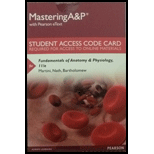
Mastering A&P with Pearson eText -- Standalone Access Card -- for Fundamentals of Anatomy & Physiology (11th Edition)
11th Edition
ISBN: 9780134478692
Author: Frederic H. Martini, Judi L. Nath, Edwin F. Bartholomew
Publisher: PEARSON
expand_more
expand_more
format_list_bulleted
Question
Chapter 21, Problem 11RQ
Summary Introduction
Introduction:
The capillary action is dependent on two factors namely the hydrostatic pressure and the osmotic pressure. Both these factors play an essential role in the movement of water through the capillary. The hydrostatic pressure pushes substance out of capillary while the osmotic pressure brings substances into the capillary.
Expert Solution & Answer
Want to see the full answer?
Check out a sample textbook solution
Students have asked these similar questions
What forces drive fluid to move OUT of capillaries and INTO capillaries?
What is colloid osmotic pressure? In which direction does colloid osmotic pressure drive the movement of water in a capillary?
Blood pressure at the arterial end of capillaries is about 40 mm Hg in humans. If blood pressure at the venous end is about 15 mm Hg, and colloid osmotic pressure is 25 mm Hg throughout, what is the net effect on fluid movement between capillaries and tissue spaces?
Chapter 21 Solutions
Mastering A&P with Pearson eText -- Standalone Access Card -- for Fundamentals of Anatomy & Physiology (11th Edition)
Ch. 21 - Prob. 1CPCh. 21 - Prob. 2CPCh. 21 - Why are valves located in veins but not in...Ch. 21 - Where in the body would you find fenestrated...Ch. 21 - Prob. 5CPCh. 21 - In a healthy person, where is blood pressure...Ch. 21 - Prob. 7CPCh. 21 - Prob. 8CPCh. 21 - Describe the actions of vasodilators and local...Ch. 21 - Prob. 10CP
Ch. 21 - Prob. 11CPCh. 21 - Why does blood pressure increase during exercise?Ch. 21 - Prob. 13CPCh. 21 - Prob. 14CPCh. 21 - Prob. 15CPCh. 21 - Identify the major patterns of blood vessel...Ch. 21 - Prob. 17CPCh. 21 - Prob. 18CPCh. 21 - Prob. 19CPCh. 21 - Prob. 20CPCh. 21 - Isabella is in an automobile accident and her...Ch. 21 - Prob. 22CPCh. 21 - Prob. 23CPCh. 21 - Name the three vessels that carry blood to and...Ch. 21 - A blood sample taken from an umbilical cord...Ch. 21 - Prob. 26CPCh. 21 - Prob. 27CPCh. 21 - Prob. 28CPCh. 21 - Prob. 29CPCh. 21 - Prob. 30CPCh. 21 - Prob. 31CPCh. 21 - Prob. 1RQCh. 21 - The blood vessels that play the most important...Ch. 21 - Prob. 3RQCh. 21 - Prob. 4RQCh. 21 - Prob. 5RQCh. 21 - Prob. 6RQCh. 21 - Prob. 7RQCh. 21 - Prob. 8RQCh. 21 - Prob. 9RQCh. 21 - Prob. 10RQCh. 21 - Prob. 11RQCh. 21 - Prob. 12RQCh. 21 - Prob. 13RQCh. 21 - Prob. 14RQCh. 21 - Prob. 15RQCh. 21 - Prob. 16RQCh. 21 - What are the primary forces that cause fluid to...Ch. 21 - Prob. 18RQCh. 21 - A major difference between the arterial and venous...Ch. 21 - Which of the following conditions would have the...Ch. 21 - Which of the following is greater? (a) the osmotic...Ch. 21 - Prob. 22RQCh. 21 - Why do capillaries pennit the diffusion of...Ch. 21 - Prob. 24RQCh. 21 - Prob. 25RQCh. 21 - Prob. 26RQCh. 21 - Compare the effects of the cardioacceleratory and...Ch. 21 - Bob is sitting outside on a warm day and is...Ch. 21 - People with allergies commonly take antihistamines...Ch. 21 - Jolene awakens suddenly to the sound of her alarm...Ch. 21 - Prob. 1CCCh. 21 - Prob. 2CC
Knowledge Booster
Similar questions
- Hydrostatic pressure pushes fluid into / out of capillaries. Osmotic pressure drives fluid into / out of capillariesarrow_forwardHow do hydrostatic and osmotic pressures determine fluid movement across the walls of capillaries?arrow_forwardWhat types of exchange between the plasma and the interstitial fluid takes place across the walls of capillaries?arrow_forward
- Describe the relationship between blood pressure and the total cross-sectional area of arteries, arterioles, and capillaries. Describe how arterioles influence blood flow through capillaries and arterial blood pressure.arrow_forwardWhat force is responsible for moving fluids out of capillaries at the arteriole end and moving fluids back into the capillary at the venule end? What happens to fluids that do not re-enter the capillaries?arrow_forwardContrast diffusion and bulk flow. Which mechanism is more important in the exchange of nutrients, oxygen, and metabolic end products across the capillary wall?arrow_forward
- If a patient has cirrhosis of the liver and is unable to produce sufficient albumin and other plasma proteins, then what variable is changed in capillary exchange, and what is the effect? a. There is no change in the capillary exchange process. b. Hydrostatic pressure in the blood decreases, and fluid remains in the blood. c. Colloid osmotic pressure in the capillary increases, and blood volume increases in the blood vessels. d. Colloid osmotic pressure in the capillary decreases, and fluid remains in the interstitial fluid, potentially causing edema.arrow_forwardAccording to Poiseuille's Law, vasodilation is associated with increased blood flow. Knowing that capillaries cannot change diameter but arterioles can, how do your observations support this?arrow_forwardDescribe the mechanisms by which substances enter and leavecapillaries.arrow_forward
- What four variables determine the net filtration pressure across the capillary wall?arrow_forwardWhat is the only solute that has a significant concentration difference across the capillary wall? How does this difference influence water concentration?arrow_forwardWhat are the principal inputs to and outputs from the cardiovascular center?arrow_forward
arrow_back_ios
SEE MORE QUESTIONS
arrow_forward_ios
Recommended textbooks for you
 Human Physiology: From Cells to Systems (MindTap ...BiologyISBN:9781285866932Author:Lauralee SherwoodPublisher:Cengage Learning
Human Physiology: From Cells to Systems (MindTap ...BiologyISBN:9781285866932Author:Lauralee SherwoodPublisher:Cengage Learning

Human Physiology: From Cells to Systems (MindTap ...
Biology
ISBN:9781285866932
Author:Lauralee Sherwood
Publisher:Cengage Learning